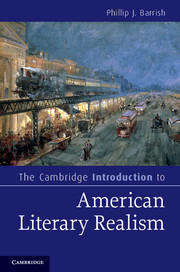Book contents
- Frontmatter
- Contents
- Illustrations
- Acknowledgments
- Introduction: American literary realism
- Chapter 1 Literary precursors, literary contexts
- Chapter 2 The “look of agony” and everyday middle-class life
- Chapter 3 Creating the “odour” of the real
- Chapter 4 Conflicting manners
- Chapter 5 “Democracy in literature”?
- Chapter 6 “The blab of the pave”
- Chapter 7 Crisis of agency
- Chapter 8 “Certain facts of life”
- Chapter 9 “The unjust spirit of caste”
- Chapter 10 New Americans write realism
- Conclusion: realisms after realism
- Notes
- Works cited
- Index
Chapter 2 - The “look of agony” and everyday middle-class life
three transitional works
Published online by Cambridge University Press: 05 June 2012
- Frontmatter
- Contents
- Illustrations
- Acknowledgments
- Introduction: American literary realism
- Chapter 1 Literary precursors, literary contexts
- Chapter 2 The “look of agony” and everyday middle-class life
- Chapter 3 Creating the “odour” of the real
- Chapter 4 Conflicting manners
- Chapter 5 “Democracy in literature”?
- Chapter 6 “The blab of the pave”
- Chapter 7 Crisis of agency
- Chapter 8 “Certain facts of life”
- Chapter 9 “The unjust spirit of caste”
- Chapter 10 New Americans write realism
- Conclusion: realisms after realism
- Notes
- Works cited
- Index
Summary
In 1861, the same year that the Civil War (1861–65) began, the reclusive poet Emily Dickinson wrote,
I like a look of agony,
Because I know it’s true;
Men do not sham convulsion,
Nor simulate a throe.
Dickinson’s poem asserts that the “look” or appearance of agony – sharp, intense pain – carries with it a conviction of reality.
- Type
- Chapter
- Information
- The Cambridge Introduction to American Literary Realism , pp. 26 - 40Publisher: Cambridge University PressPrint publication year: 2011

